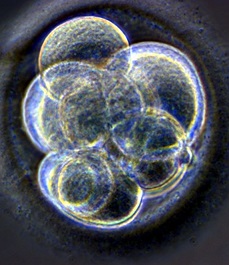Lab embryos advanced
 A happy coincidence in a lab could revolutionise embryo models and targeted drug therapies.
A happy coincidence in a lab could revolutionise embryo models and targeted drug therapies.
Materials scientists at UNSW Sydney have shown that human pluripotent stem cells in a lab can initiate a process resembling the gastrulation phase - where cells begin differentiating into new cell types - much earlier than occurs in nature.
Developmental biologist Lewis Wolpert once said: “It is not birth, marriage or death, but gastrulation which is truly the most important time in your life.”
Gastrulation is the key event in an embryo’s development when a mass of undifferentiated cells begin the first steps of a long journey in the womb towards formation of a human being. This is one of the reasons that work on embryos left over from IVF is forbidden beyond 14 days, when gastrulation occurs.
While for an embryo developing in the womb, gastrulation occurs at day 14, in a dish in a lab at UNSW’s Kensington campus, Scientia Associate Professor Kris Kilian has overseen an experiment where a gastrulation-like event was triggered within two days of culturing human stem cells in a unique biomaterial that, as it turned out, set the conditions to mimic this stage of embryo development.
“Gastrulation is the key step that leads to the human body plan,” says A/Prof. Kilian.
“It is the start of the process where a simple sheet of cells transforms to make up all the tissues of the body – nerves, cardiovascular and blood tissue and structural tissue like muscle and bone.
“But we haven’t really been able to study the process in humans because you can’t study this in the lab without taking developing embryonic tissue.
“So it’s really exciting that we were able to see this happening in vitro.”
The achievement not only has implications for the understanding of human embryonic development, but also new treatments in medicine including cell therapy, targeted drug development and CRISPR gene-editing technologies.
A/Prof Kilian says that up until now, it has been difficult to study this process in humans because of obvious ethical constraints.
“Controlling gastrulation using materials alone will provide an entirely new way for studying human development,” he said.
“We currently can’t do this because embryo research beyond 14 days is often viewed as unethical, and it’s currently impossible in vivo because you’d need to observe an embryo in a pregnant human mother.”
But while there are animal models to study - such as mice and zebrafish - and other researchers have induced gastrulation-like events in the lab using chemicals including growth factors, this is the first time culture conditions alone have initiated gastrulation outside of a human body.
“Our method could lead to a new approach to mimic human embryogenesis outside of a person,” A/Prof Kilian says.
As with many great discoveries in science, serendipity played a role. The team was not actively looking to bring on gastrulation when they dropped some stem cells onto a hydrogel substrate.
Lead author Dr Pallavi Srivastava was surprised by what she observed.
“Initially I was trying to get stem cells to attach to our hydrogels and planned to differentiate them in the conventional way,” she said.
“The difference between cells cultured on glass and those on our gels was very striking. I remember thinking, ‘wow, something is going on here. I need to investigate’. This led to a big shift in my project, and ultimately this exciting discovery.”
The researchers are hopeful they can continue exploring the benefits of their discovery by understanding how materials can guide embryogenesis and beyond.
A/Prof Kilian says that while this finding is exciting, more work is needed to guide the gastrulation-like processes to form useful tissues.
“This is really the first step in what we hope is a platform technology for producing useful tissue models. Triggering gastrulation is not enough – now we need to provide other signals to keep differentiation going.”
Discovering the next set of materials signals may allow creation of virtually any solid tissue for research purposes, A/Prof Kilian says, and for generating useful cell types for regenerative medicine.
“Considering pluripotent stem cells can now be generated from blood or tissue samples, the future is wide open for regenerating tissues and organs from a patient’s own cells.”
The full study is accessible here.








 Print
Print